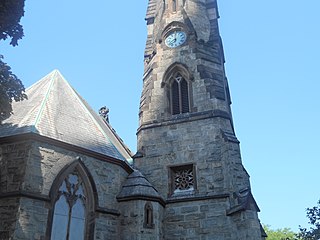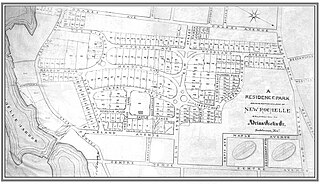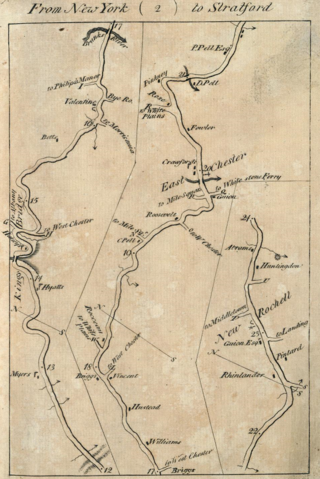
Westchester County is located in the U.S. state of New York. It is the seventh most populous county in the State of New York and the most populous north of New York City. According to the 2020 United States Census, the county had a population of 1,004,456, its highest decennial count ever and an increase of 55,344 (5.8%) from the 949,113 counted in 2010. Westchester covers an area of 450 square miles (1,200 km2), consisting of six cities, 19 towns, and 23 villages. Established in 1683, Westchester was named after the city of Chester, England. The county seat is the city of White Plains, while the most populous municipality in the county is the city of Yonkers, with 211,569 residents per the 2020 census. The county is part of the Hudson Valley region of the state.

New Rochelle is a city in Westchester County, New York, United States. It's a suburb of New York City, located approximately 17 miles (27 km) from Midtown Manhattan. In 2020, the city had a population of 79,726, making it the 7th-largest city and 22nd-most populous municipality in New York. Some residents refer to the city as New Ro. A well-known destination within New Rochelle is "New Roc City," which has restaurants and entertainment venues.

Trinity-St. Paul's Episcopal Church in New Rochelle in Westchester County, New York was added to the National Register of Historic Places in 2006. It is located at the northwest corner of Huguenot Street and Division Street. This church represents the body of the majority group of New Rochelle's founding Huguenot French Calvinistic congregation that conformed to the liturgy of the established Church of England in June 1709. King George III gave Trinity its first charter in 1762. After the American Revolutionary War, Trinity became a parish of the Protestant Episcopal Church of America.

The main U.S. Post Office in New Rochelle is located at 255 North Avenue, at the intersection of North Avenue and Huguenot St., in the city of New Rochelle in Westchester County, New York. The facility currently serves the 10801, 10803 and 10805 ZIP Codes, covering portions of New Rochelle and neighboring Pelham and Pelham Manor.
Rochelle Heights is a historic residential neighborhood in the city of New Rochelle, in Westchester County, New York. The area is bordered by the City Park area on the east, Interstate 95 on the south, and Rochelle Park on the west. The Rochelle Heights and Rochelle Park neighborhoods together create the Rochelle Park-Rochelle Heights Historic District.
Rochelle Park is a historic residential neighborhood in the city of New Rochelle, in Westchester County, New York. The area is bordered by Rochelle Heights on the east, Interstate 95 on the south, New Rochelle City Hall and civic center on the west and Iona College on the north. The Rochelle Heights and Rochelle Park neighborhoods together create the Rochelle Park-Rochelle Heights Historic District.

The Rochelle Park–Rochelle Heights Historic District is a historic residential district located in the city of New Rochelle in Westchester, New York. The district is historically and architecturally significant as an intact and distinctive example of residential park development at the turn of the Twentieth Century. It includes the historic Rochelle Park development, and the later Rochelle Heights subdivision. Within the district are 555 contributing properties, including 513 buildings, 38 structures, and 4 sites. Only 24 buildings and 1 site separately identified within its area are non-contributing. It was listed on the National Register of Historic Places (NRHP) on July 6, 2005.

The Lispenard–Rodman–Davenport House is a historic residence dating back to the early 18th century located on the Davenport Neck peninsula in New Rochelle, New York. The house is the oldest residential structure in New Rochelle. It was listed on the National Register of Historic Places in 1986.
New Rochelle is a city in Westchester County, New York, United States, in the southeastern portion of the state. The town was settled by Huguenots in 1688 who fled France following their failed rebellions. Many of the settlers were wealthy merchants, artisans and craftsmen from the city of La Rochelle, France, thus influencing the choice of the name of "New Rochelle".
Thaddeus Davids was a 19th-century New York businessman who, in partnership with his brothers, built one of the largest ink companies in the world at the time.

The Jacob Leisler Monument is a bronze sculpture created by American artist Solon Borglum and located in the city of New Rochelle, in Westchester County, New York. The monument was erected by the Huguenot Chapter of the Daughters of the American Revolution, and the Huguenot Association of New Rochelle to the memory of Jacob Leisler, 17th-century advocate of the Huguenot settlers and said to be the first chief executive of the province of New York to draw his power directly from the people. The unveiling of the statue on June 24, 1913, was the principal event in the celebration of the 250th anniversary of the founding of New Rochelle. The monument, cast by the Roman Bronze Works, is the only existing statue of Leisler.
There are numerous nationally and locally designated historic sites and attractions in Westchester County. These include architecturally significant manors and estates, churches, cemeteries, farmhouses, African-American heritage sites, and underground railroad depots and waystations. There are sites from pre-Revolutionary and Revolutionary times, as well as battlegrounds. Westchester County also played an important role in the development of the modern suburb, and there are many associated heritage sites and museums.

Residence Park is a historic community located in the city of New Rochelle, in Westchester County, New York. It is one of the first planned residential parks, and garden city communities, in the United States. It is located in the southern section of the city, bordered by Neptune Park on the west, Shore Road and Long Island Sound on the south, and Downtown New Rochelle on the north.

Middletown is a former hamlet of the Town of New Rochelle in Westchester County, New York. The hamlet took shape in the central portion of New Rochelle, extended along North Avenue from the vicinity of Rochelle Park to the southerly boundary of the Wykagyl Country Club grounds. The origin of the name is traceable to a division of the town road districts. As early as 1747, there were two main districts: "upper" and "below". An increase in population after the Revolutionary War warranted the further subdivision of the town into five road districts in 1787. One was named "Middle" to distinguish it from the "Upper", "Waterside" and "Town" districts. By this time the district had become quite well built up so as to make the term "town" appropriate. Hence it became "Middletown". The name was so appropriate to the hamlet that it was indicated on road maps beginning in 1789.

Titus Mill Pond & New York State Tidal Wetlands is located at the northeastern end of New Rochelle Harbor in the city of New Rochelle in Westchester, New York. The waters in the harbor and pond flow from Long Island Sound, with tides up to eight feet in the inlet and with no fresh water stream entering into it.
New Rochelle Historic Site is a designation of the Historical and Landmarks Review Board (HLRB), for buildings, structures, monuments and other historically significant properties in the city of New Rochelle in Westchester County, New York. Significant sites are chosen after meeting a combination of criteria, including historical, economic, architectural, artistic, cultural, and social values.

Davenport Neck is a peninsula in New Rochelle, New York, extending southwesterly from the mainland into Long Island Sound, and running parallel to the main shore. It divides the city's waterfront into two, with New Rochelle Harbor to the south and southwest, and Echo Bay, to the north and northeast. Glen Island and Neptune Island lie just to the west of the Neck, and Davids and Huckleberry islands lie to the south.
Crystal Lake was located in the village of New Rochelle in Westchester County, New York. It originally supplied early colonial mills with water power. It was fed by Stephenson Brook, which rises just north of Paine Lake and drains the large watershed adjacent to North Avenue from beyond Quaker Ridge Road.
Pelham Road, known as Shore Road within the Bronx, is a historic 4.1-mile (6.6 km) east-west road that runs along the Long Island Sound shoreline from Pelham Bay Park in the Bronx through the southern Westchester County, New York communities of New Rochelle and Pelham Manor. The thoroughfare had its beginning as a Native American trail linking the important villages on Davenport Neck to those on Pelham Neck in Pelham. Between these points along the shore line there was an almost continuous chain of small Indian villages and camps. This waterfront area was especially advantageous, with many small coves in secure harbors and protected by adjacent islands and many small streams of water and abundant springs.










